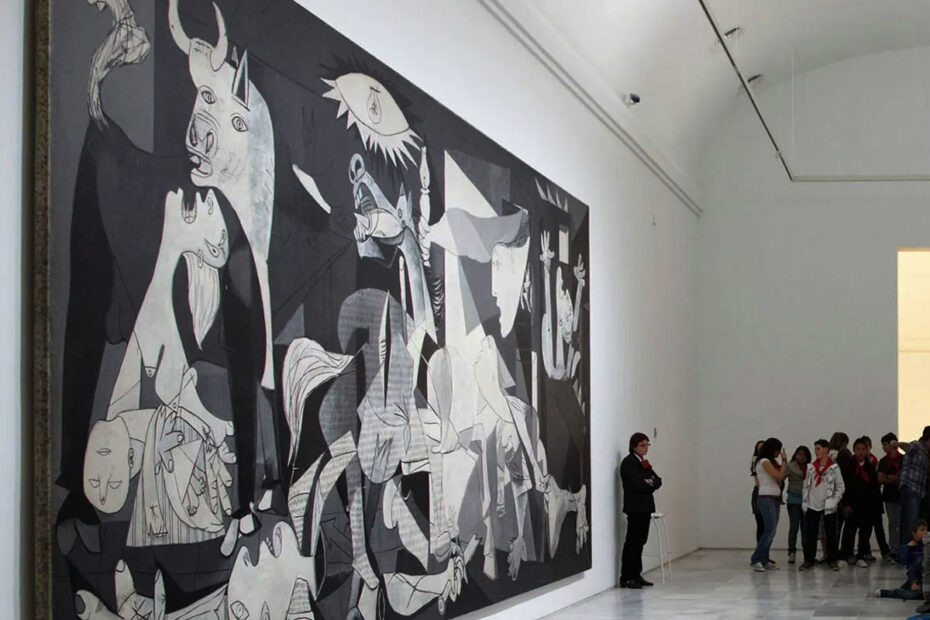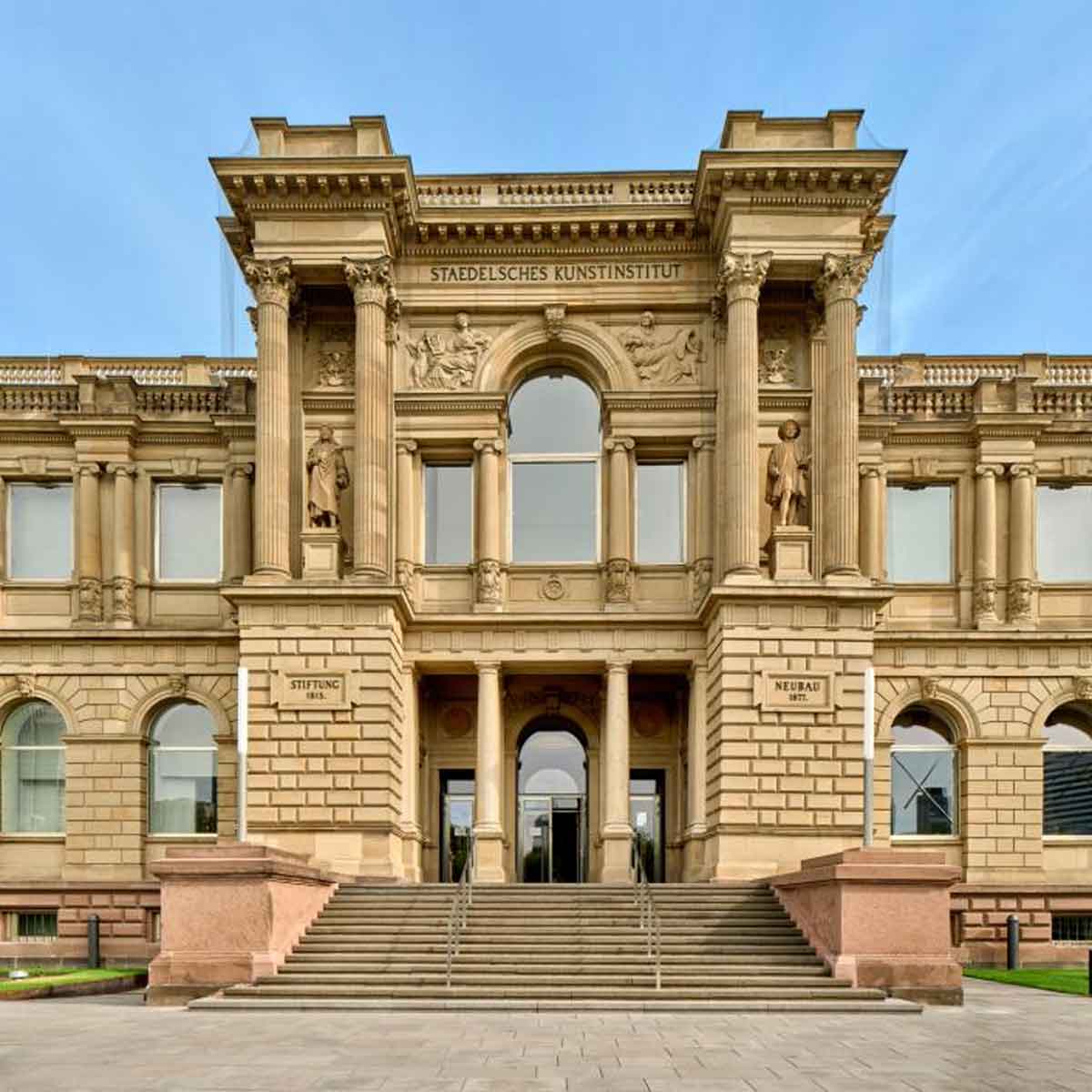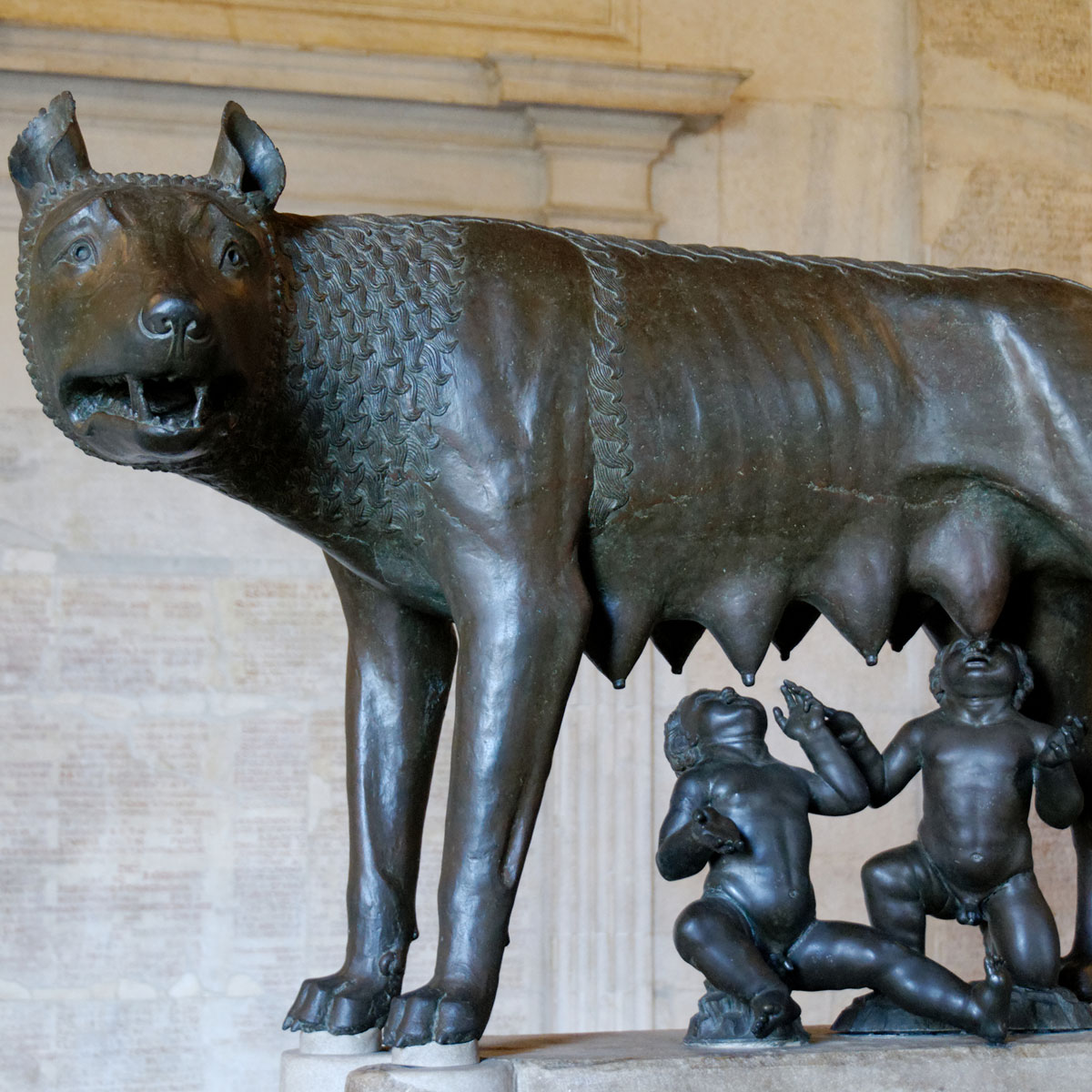Spain is a country with an enormous cultural wealth spanning centuries of history. This translates into a great production of works of art. In this article we are going to show you the best art museums in Spain, some of which are among the most visited around the world
What are the best museums in Spain?
1- Prado Museum, Madrid

The Prado Museum, officially known as the Museo Nacional del Prado, is the main Spanish art museum, located in the center of Madrid
It is considered to house one of the finest collections of European art in the world, from the 12th century to the early 20th century, based on the former Spanish Royal Collection, and the best collection of Spanish art. Founded as a museum of painting and sculpture in 1819, it also contains important collections of other types of works
The Prado Museum is one of the most visited places in the world, and is considered one of the greatest art museums in the world

The numerous works by Francisco Goya, the most represented artist, as well as Hieronymus Bosch, El Greco, Pedro Pablo Rubens, Titian and Diego Velázquez, are some of the highlights of the collection. Velázquez and his keen eye and sensitivity were also responsible for bringing to Spain much of the museum’s excellent collection of Italian masters, which is now one of the largest outside Italy.
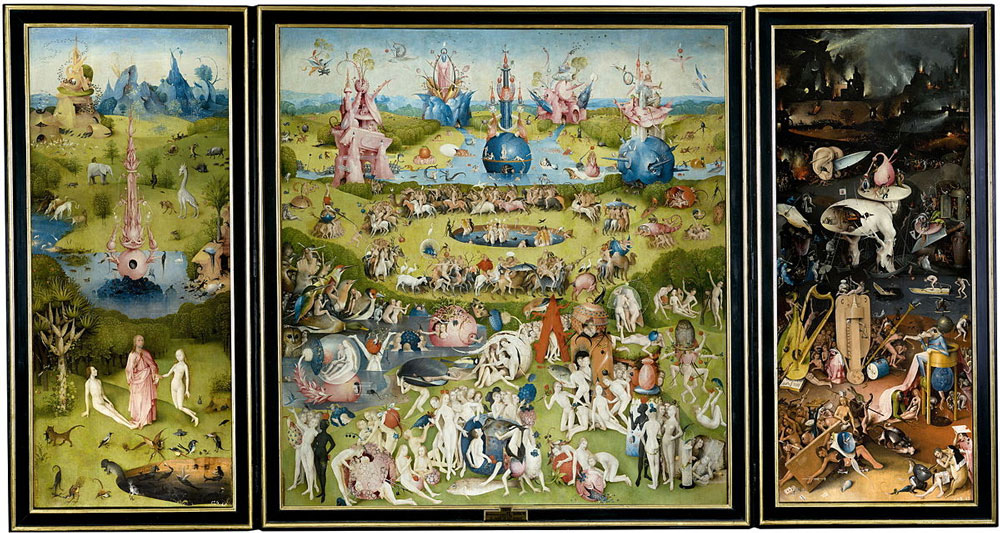
Today, the collection includes some 8,200 drawings, 7,600 paintings, 4,800 prints and 1,000 sculptures, in addition to many other works of art and historical documents. In 2012, the museum exhibited about 1,300 works in the main buildings, while about 3,100 works were on temporary loan to various museums and official institutions. The rest were in storage.
Due to the COVID-19 pandemic, in 2020 attendance was down 76% to 852,161 viewers. Nevertheless, the Prado ranked as the 16th most visited museum on the list of the world’s most visited art museums in 2020.
The Prado, along with the nearby Thyssen-Bornemisza Museum and the Reina Sofia Museum, forms Madrid’s Golden Triangle of Art, which was included on UNESCO’s World Heritage List in 2021.
2- The Thyssen-Bornemisza National Museum

The Museo Nacional Thyssen-Bornemisza, or simply the Thyssen, is an art museum in Madrid, Spain, located near the Prado Museum on one of the city’s main boulevards. It is known as part of the “Golden Triangle of Art”, which also includes the Prado and Reina Sofia national galleries
The Thyssen-Bornemisza fills the historical gaps in the collections of its counterparts: in the case of the Prado it is Italian primitives and works from the English, Dutch and German schools, while in the case of the Reina Sofia it is Impressionists, Expressionists and 20th-century European and American painting.
With more than 1,600 paintings, it was once the second most important private collection in the world, after the British Royal Collection
In 1987-88 a competition was held to house the core of the collection, after Baron Thyssen, having unsuccessfully applied for permission to expand his Museum in Lugano (Villa Favorita), sought a more suitable site elsewhere in Europe.
The Old Masters were purchased mainly by the senior Baron, while Hans focused more on the 19th and 20th centuries, resulting in a collection that spans eight centuries of European painting, without claiming to give an overall view but rather a series of highlights.

One of the focal points is early European painting, with an important collection of Italian paintings from the trecento and quattrocento (i.e., the fourteenth and fifteenth centuries) by Duccio, Luca di Tommè, Bernardo Daddi, Paolo Uccello, Benozzo Gozzoli and their contemporaries, and works by early Flemish and Dutch painters such as Jan van Eyck (Diptych of the Annunciation), Petrus Christus (Madonna of the Dry Tree), Robert Campin, Rogier van der Weyden, Gerard David and Hans Memling.
The Museum houses an exhibition of American paintings from the 18th and 19th centuries, such as Copley, Winslow Homer or John Singer Sargent.
The 19th century European exhibition begins with works by Francisco Goya, Thomas Lawrence, Delacroix, Géricault, Corot and Courbet
There are Impressionist and Post-Impressionist works by artists Claude Monet, Auguste Renoir, Edgar Degas, Camille Pissarro, Alfred Sisley, Pierre Bonnard, Toulouse-Lautrec, Paul Gauguin, Cézanne and Vincent van Gogh
The extensive collection of 20th-century modern art includes Cubist works by Picasso, Braque and Juan Gris, as well as paintings by Edvard Munch, Egon Schiele, James Ensor, Kandinsky, Salvador Dalí, Paul Klee, Chagall, Magritte, Piet Mondrian, Edward Hopper, Jackson Pollock, Mark Rothko, Roy Lichtenstein, Willem de Kooning and Francis Bacon.
The selection of German Expressionism is extensive, including Emil Nolde, Ernst Ludwig Kirchner, August Macke, Max Beckmann, George Grosz and Otto Dix.
A collection of works from the museum(Fra Angelico, Cranach, Titian, Canaletto) is housed in Barcelona at the Museu Nacional d’Art de Catalunya.
One of the paintings, Saint-Honoré Street in the Afternoon, Effect of Rain, by Camille Pissarro, belonged to a Jewish woman, Lilly Cassirer, who was forced by a Nazi official to exchange it under duress for an exit visa to escape Nazi Germany shortly after Kristallnacht in 1939
In 2015, her descendants filed a lawsuit against the museum, claiming it had been looted by the Nazis. On May 1, 2019, a California judge ruled that the museum had the right to keep the painting, despite international agreements to the contrary. The case went before the U.S. Supreme Court on January 18, 2022.
3- Museo Nacional Centro de Arte Reina Sofía
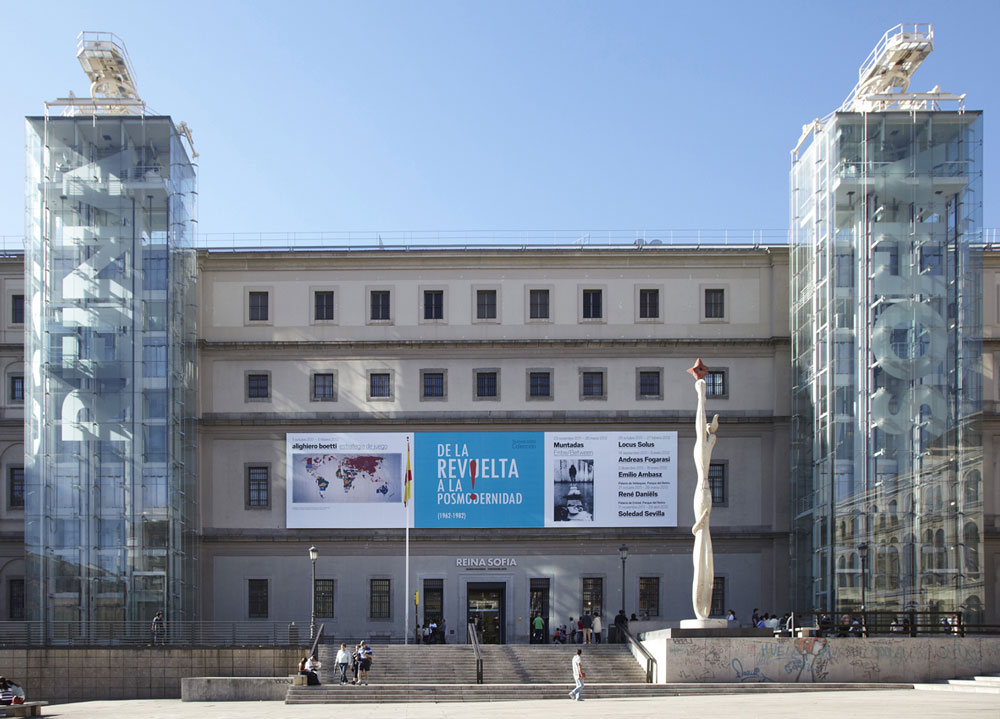
The Museo Nacional Centro de Arte Reina Sofía (MNCARS) is Spain’s national museum of 20th century art. It was officially inaugurated on September 10, 1990 and is named after the Reina Sofia. It is located in Madrid, near the Atocha train and metro stations, at the southern end of the so-called Golden Triangle of Art (located along the Paseo del Prado and also comprising the Prado Museum and the Thyssen-Bornemisza Museum).
The museum is mainly dedicated to Spanish art. The highlights of the museum are the excellent collections of the two great Spanish masters of the 20th century, Pablo Picasso and Salvador Dalí

The museum’s most famous masterpiece is Picasso’s 1937 painting Guernica. In addition to its extensive collection, the museum offers a mix of national and international temporary exhibitions in its many galleries, making it one of the largest museums of modern and contemporary art in the world
In 2020, due to the COVID-19 pandemic it attracted only 1,248,480 visitors, down 72% from 2019, but it still ranks sixth on the list of most visited art museums in the world.
It also houses a free-access library specializing in art, with a collection of more than 100,000 books, more than 3,500 sound recordings and nearly 1,000 videos.
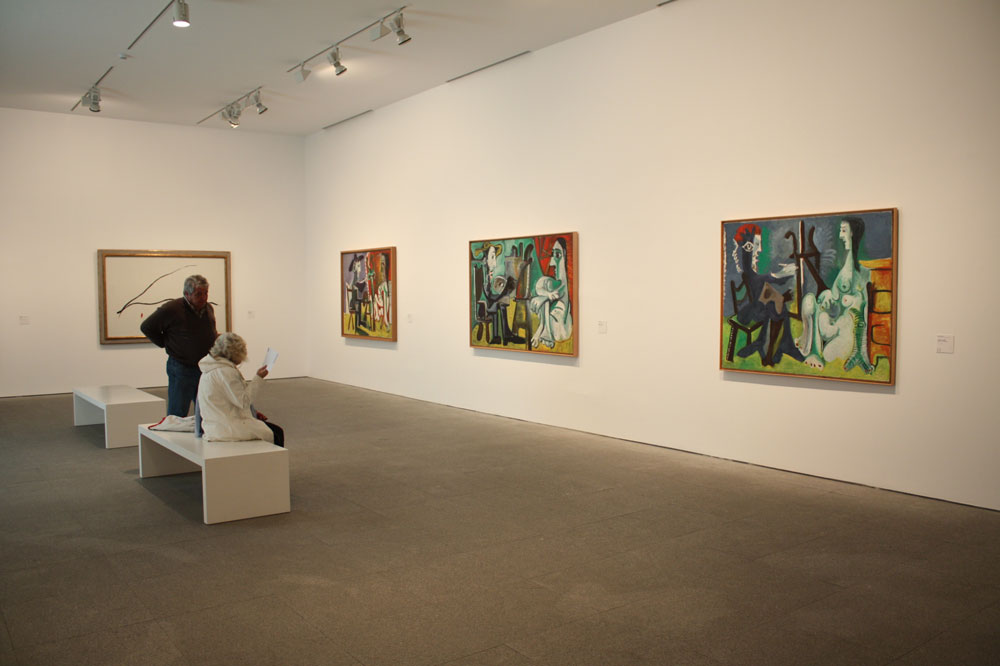
The Reina Sofia’s collection features works by artists such as Joan Miró, Eduardo Chillida, Pablo Gargallo, Julio González, Luis Gordillo, Juan Gris, José Gutiérrez Solana, Lucio Muñoz, Jorge Oteiza, Julio Romero de Torres, Pablo Serrano and Antoni Tàpies.
International art represented in the collection includes works by Francis Bacon, Joseph Beuys, Pierre Bonnard, Georges Braque, Alexander Calder, Robert Delaunay, Max Ernst, Lucio Fontana, Sarah Grilo, Damien Hirst, Donald Judd, Vasily Kandinsky, Paul Klee, Yves Klein, Fernand Léger, Jacques Lipchitz, René Magritte, Henry Moore, Bruce Nauman, Gabriel Orozco, Nam June Paik, Man Ray, Diego Rivera, Mark Rothko, Julian Schnabel, Richard Serra, Cindy Sherman, Clyfford Still, Yves Tanguy and Wolf Vostell.
4- Guggenheim Museum Bilbao
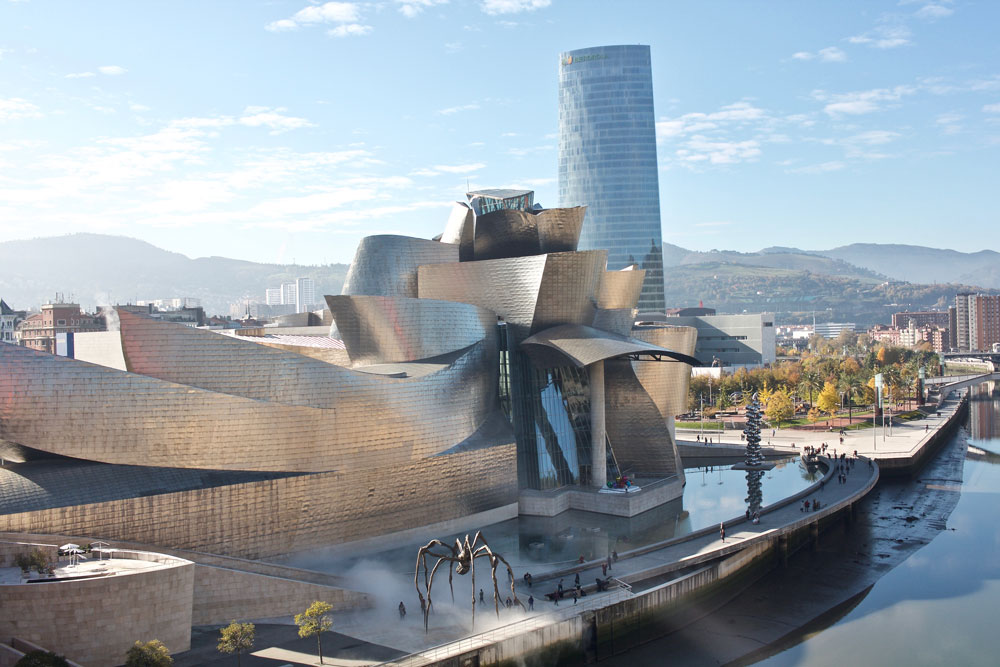
The Guggenheim Museum Bilbao is a museum of modern and contemporary art designed by Canadian-American architect Frank Gehry, and located in Bilbao, Basque Country, Spain
The museum was inaugurated on October 18, 1997 by King Juan Carlos I of Spain, with an exhibition of 250 works of contemporary art
Built along the Nervion River, which flows through the city of Bilbao to the Bay of Biscay, it is one of several museums owned by the Solomon R. Guggenheim Foundation and features permanent and temporary exhibitions of works by Spanish and international artists. It is one of the largest museums in Spain.
In 2020, the museum had 315,908 visitors, down 73% from 2019, due to the COVID-19 pandemic. It ranked 73rd on the list of most visited art museums in 2020.
One of the most admired works of contemporary architecture, the building has been hailed as a “signal moment in architectural culture,” as it represents “one of those rare moments when critics, academics and the general public were completely united about something,” according to architecture critic Paul Goldberger.
The museum was the building most named as one of the most important works completed since 1980 in the 2010 World Architecture Survey among architectural experts.
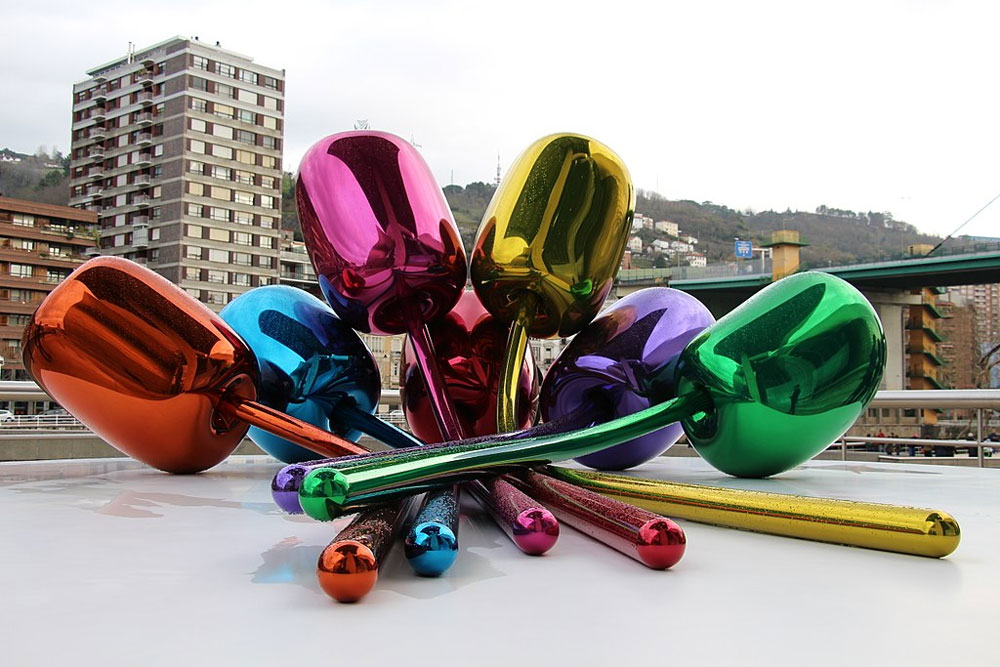
The museum notably houses “large-scale, site-specific works and installations by contemporary artists,” such as Richard Serra‘s 100-meter-long Serpentine, and showcases the work of Basque artists, “as well as housing a selection of works” from the Foundation’s modern art collection.
In 1997, the museum inaugurated “The Guggenheim Museums and the Art of This Century,” an overview of 300 works of 20th-century art, from Cubism to new media art. Most of the pieces came from the Guggenheim’s permanent collection, but the museum also acquired paintings by Willem de Kooning, Mark Rothko and Clyfford Still and commissioned new works by Francesco Clemente, Anselm Kiefer, Jenny Holzer and Richard Serra.
Exhibitions change often; the museum often hosts thematic exhibitions, focusing, for example, on Chinese or Russian art
Traditional paintings and sculptures are in the minority compared to installations and electronic forms
The highlight of the collection, and its only permanent exhibition, is The Matter of Time (which incorporates an earlier work, Snake), a series of aged steel sculptures designed by Serra, housed in the 130-meter Arcelor Gallery (formerly known as the Fish Gallery, but renamed in 2005 for the steel manufacturer that sponsored the project)
The collections typically highlight avant-garde art, 20th-century abstraction, and non-objective art
5- Picasso Museum, Barcelona
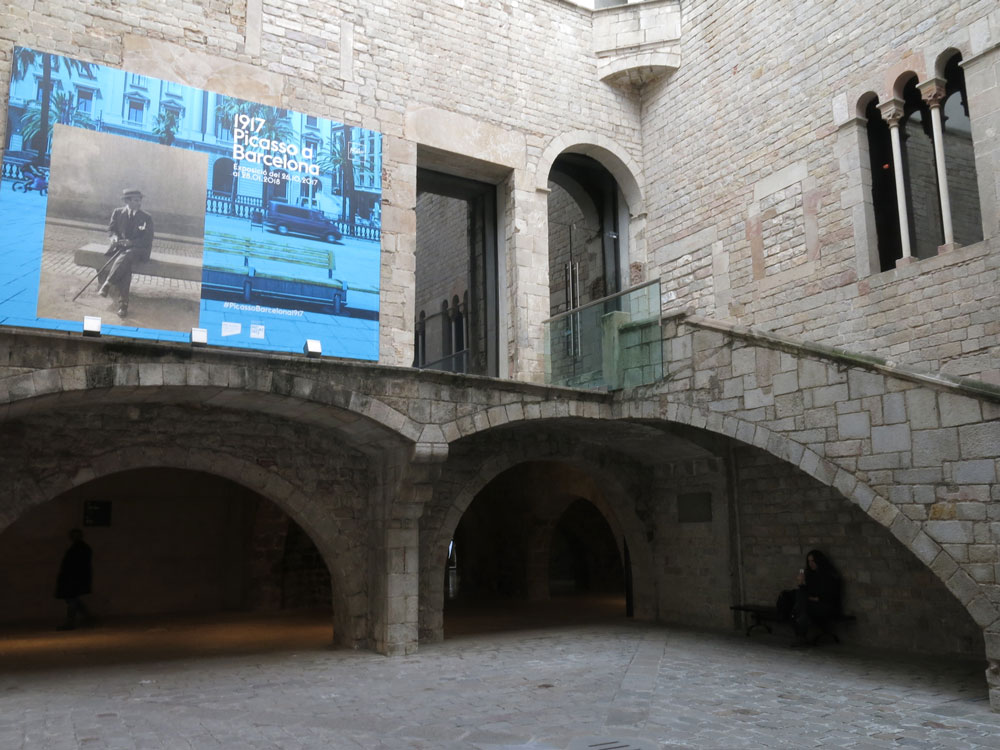
The Picasso Museum is an art museum in Barcelona, Catalonia, Spain. It houses an extensive collection of works of art by the 20th century Spanish artist Pablo Picasso, with a total of 4251 of his works
It is housed in five adjoining medieval palaces on Montcada Street in the La Ribera district of Barcelona’s old town. It opened to the public on March 9, 1963, becoming the first museum dedicated to Picasso’s work and the only one created during his lifetime. Since then, it has been declared a museum of national interest by the Generalitat de Catalunya.
The collection includes two of his earliest important works, The First Communion (1896) and Science and Charity (1897). In particular, the Picasso Museum reveals Picasso’s relationship with the city of Barcelona, a relationship that was forged in his youth and adolescence and continued until his death.
The permanent collection is organized into three sections: painting and drawing, engraving and ceramics. These mainly cover the early years of Picasso’s artistic life, such as his Blue Period from 1901 to 1904, but Picasso, his family and friends would also bequeath or lend other later pieces. Today, the museum’s permanent collection includes more than 3,500 works.
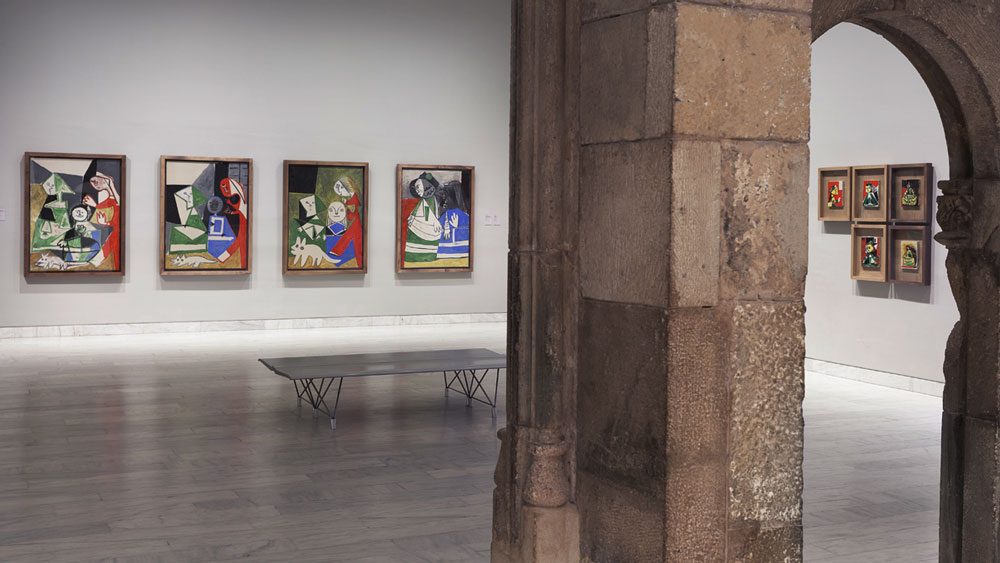
The collection is organized into areas that include the early years (Malaga, Coruña and Barcelona, 1890-97), the formative period (Barcelona, Horta de San Juan and Madrid, 1897-1901), the blue period (1901-04), works in Barcelona from 1917 onward, and the complete Las Meninas series (1957)
Most of the paintings on display in the museum are from the period between 1890 and 1917, an important collection in terms of that part of Picasso’s life. The museum has very few paintings after 1917, with the exception of Las Meninas, painted in 1957. The collection of lithographs comprises the years 1962 and 1982
Picasso himself gave the museum a copy of each of his works made after Sabartés’ death in 1968. The collection also includes illustrations made by the artist for several books, as well as ceramics given to the museum by Picasso’s widow, Jacqueline.
Between 2009 and 2010, the museum began making information about the permanent collection publicly available on its website. By October 2010, more than 65% of the museum’s collection could be viewed online.
6- National Art Museum of Catalonia
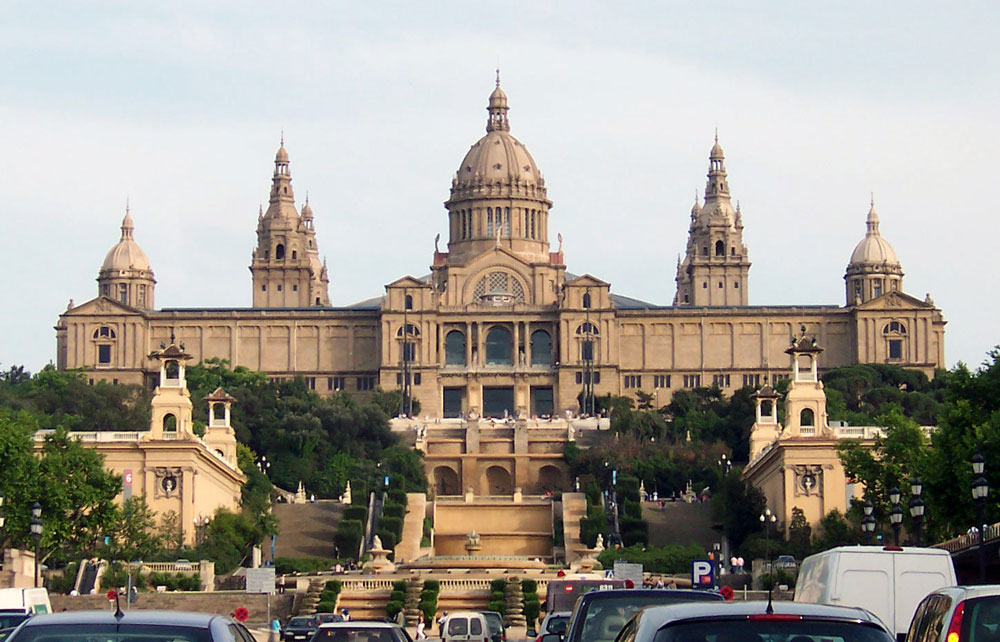
The National Art Museum of Catalonia, abbreviated as MNAC, is a museum of Catalan visual art located in Barcelona, Catalonia, Spain. Located on the hill of Montjuïc, at the end of Avinguda de la Reina Maria Cristina, near Pl Espanya.
The museum is especially notable for its outstanding collection of Romanesque ecclesiastical paintings, and for Catalan art and design from the late 19th and early 20th centuries, including modernism and noucentisme
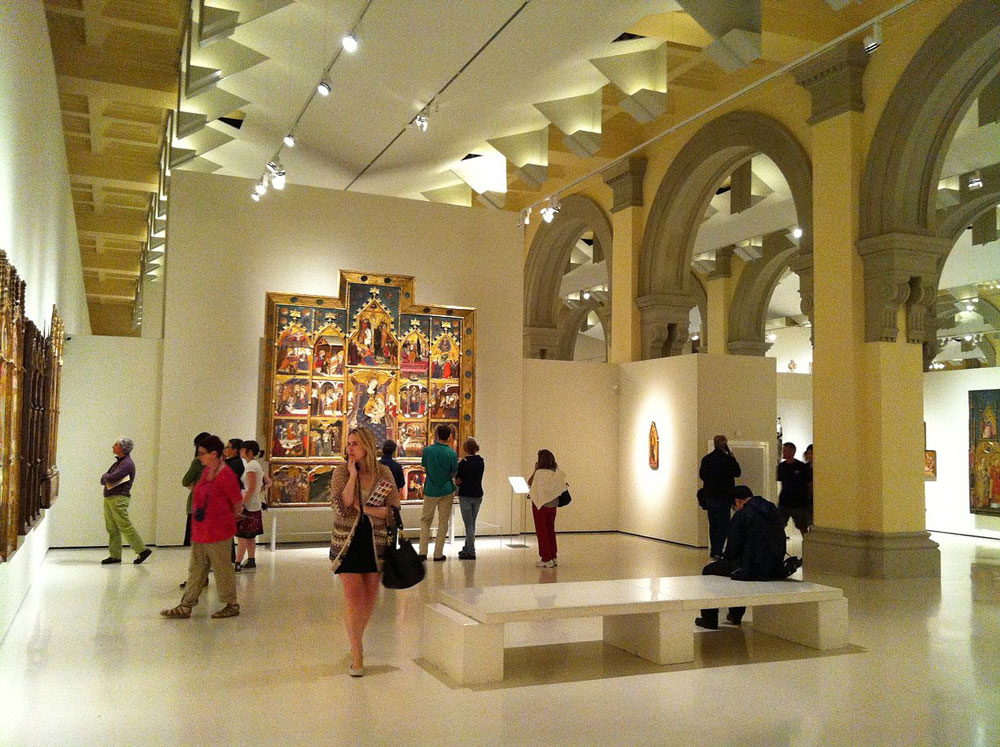
It is housed in the Palau Nacional, a huge Italian-style building dating from 1929. The Palau Nacional, which has housed the Museu d’Art de Catalunya since 1934, was declared a national museum in 1990 under the Museums Law passed by the Catalan government. That same year, a thorough renovation process was launched, based on plans drawn up by architects Gae Aulenti and Enric Steegmann, who were later joined by Josep Benedito.
The Oval Hall was reopened in 1992 for the Olympic Games, and the various collections were installed and inaugurated between 1995 (when the Romanesque Art section was reopened) and 2004. The National Art Museum of Catalonia (Museu Nacional), one of the largest museums in Spain, was officially inaugurated on December 16, 2004.
7- Museum of Contemporary Art of Barcelona
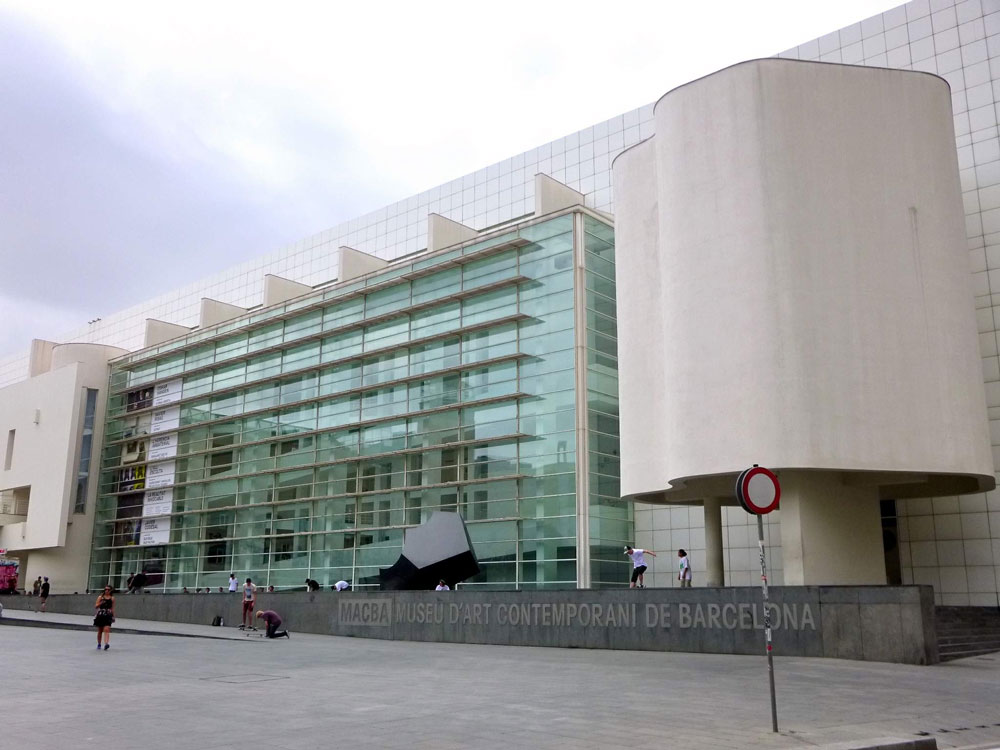
The Museum of Contemporary Art of Barcelona (MACBA) is a contemporary art museum located in the Plaça dels Àngels, in El Raval, Ciutat Vella, Barcelona, Catalonia, Spain
The museum opened its doors to the public on November 28, 1995.
The permanent collection, which numbers some 5,000 works (up from 1,100 when the museum opened in 1995), dates from the mid-20th century onward
There are three periods of modern art represented: the first covers the 1940s through the 1960s; the second covers the 1960s and 1970s; the third period is contemporary. The collections focus on Catalan and Spanish art after 1945, although some international artists are also represented.
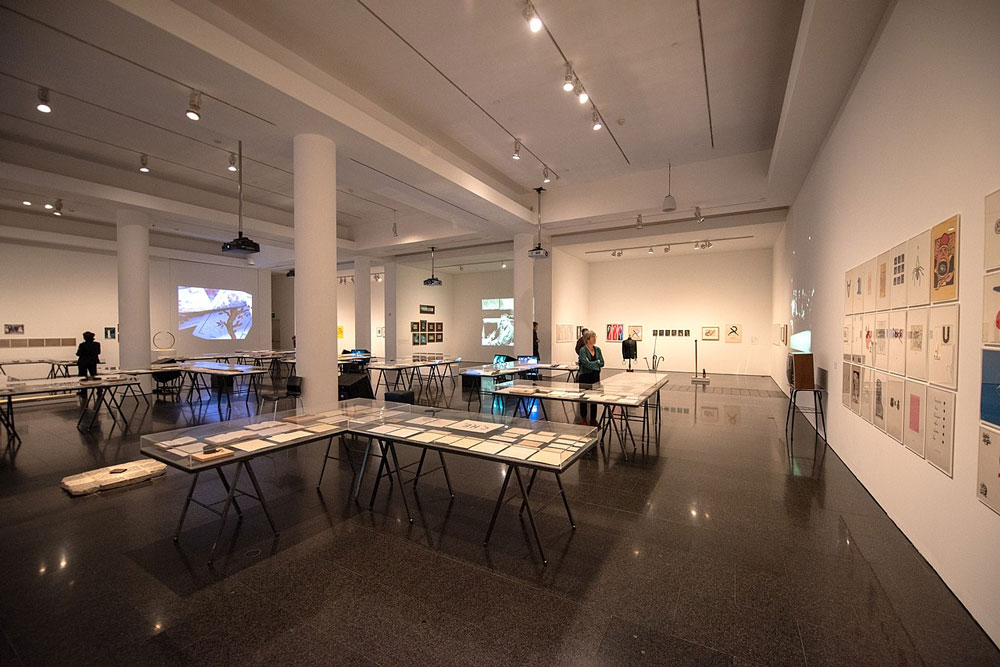
In 2007, the MACBA Studies and Documentation Center was created, which developed a complementary collecting facet to the traditional collection.
In 2011, Philippe Méaille loaned 800 works by the radical conceptualist artists’ group Art & Language to MACBA. Fearing political instability following the referendum in Catalonia in October 2017, he withdraws his loan and repatriates his collection to the Château de Montsoreau-Museum of Contemporary Art.
In 2020, under Ferran Barenblit, the most generous donation ever received by the museum, the Rafael Tous conceptual art collection, was announced.
8- Bilbao Fine Arts Museum

The Museo de Bellas Artes de Bilbao is an art museum located in the city of Bilbao, Spain. The museum building is located entirely within the city’s Doña Casilda Iturrizar Park.
It is the second largest and most visited museum in the Basque Country, after the Guggenheim Museum in Bilbao and one of the richest Spanish museums outside Madrid
It houses a valuable and fairly complete collection of Basque, Spanish and European art from the Middle Ages to contemporary, including paintings by old masters such as El Greco, Cranach, Murillo, Goya, Van Dyck, Ruisdael and Bellotto, along with 19th century and modern ones: Sorolla, Mary Cassatt, Paul Gauguin, Henri Le Sidaner, James Ensor, Peter Blake, Francis Bacon and Richard Serra.
The collection of the Bilbao Fine Arts Museum brings together an outstanding heritage of more than 10,000 pieces: approximately 1,500 paintings, 400 sculptures, more than 6,500 works on paper and a thousand pieces of applied arts
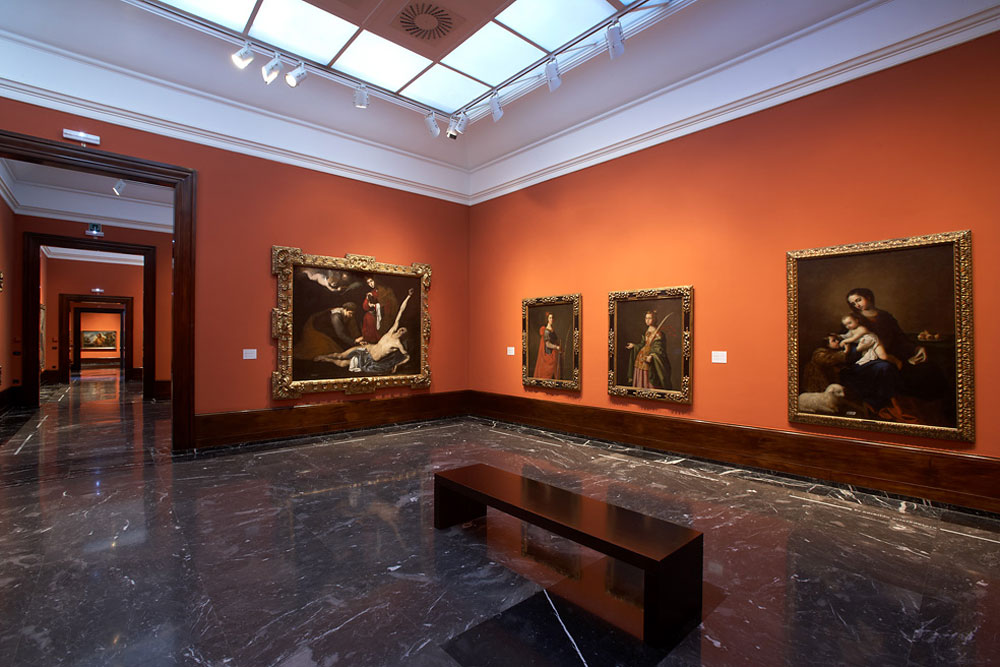
It also conserves relevant examples of some of the main European schools from the 18th century to the present day and other exceptional collections such as the Palace collection of oriental art, the collection of Manises ceramics from the 14th-16th centuries or the Taramona-Basabe collection of Etruscan, Italic, Roman and Iberian bronzes, whose chronology dates back to the 6th century BC.
The Flemish and Dutch schools of painting are of special interest, with renowned works by Gossart, Benson and Coecke, Mandijn, Vredeman de Vries, De Vos, Jordaens, Van Dyck, Grebber or Ruisdael.
In 2012 the museum has incorporated an important example of Lucas Cranach the Elder: Lucretia (1534). It also has the largest collection of Basque artists, making it the top reference institution for its artistic and documentary heritage, its research tradition and its proximity to the artists.
The variety of works on paper, prints and engravings by Albrecht Dürer, Van Meckenem, Georg Pencz, Goltzius, Rembrandt, Sandrart, Piranesi, Goya, Fortuny, Carlos de Haes, Cézanne, Picasso, Duchamp, Lipchitz, Utamaro, Hokusai, Rouault, Hockney, Allen Jones, Immendorff, Bacon and Antonio Saura, among others, stand out.
A must-see tour of the museum includes rare works by Bermejo, Benson, Mandijn, Vredeman de Vries, Lucas Cranach the Elder, De Vos, Anthonis Mor, Alonso Sanchez Coello, El Greco, Pourbus, Gentileschi, Ribera, Zurbaran, Van Dyck, Murillo, Arellano, Melendez, Bellotto, Mengs, Goya, Paret, Villaamil, Ribot, Zamacois, Madrazo, Gauguin, Cassatt, Sorolla, Iturrino, Ensor, Regoyos, Romero de Torres, Zuloaga, Sunyer, Gutiérrez Solana, Daniel Vázquez Díaz, Lipchitz, Delaunay, González, Gargallo, Bacon, Palazuelo, Oteiza, Appel, Chillida, Caro, Serra, Millares, Tàpies, Saura, Lüpertz, Kitaj, Blake, Arroyo and Barceló, among others.
Have you visited any of these museums in Spain? Leave us your opinion
If you like art and you have visited any of the museums mentioned in the list, leave us your opinion about it. Tell us about your experience, what aspects of the museum stand out, what are the works of art that have impacted you the most and if you recommend a visit
Here are other lists of museums in different countries:

